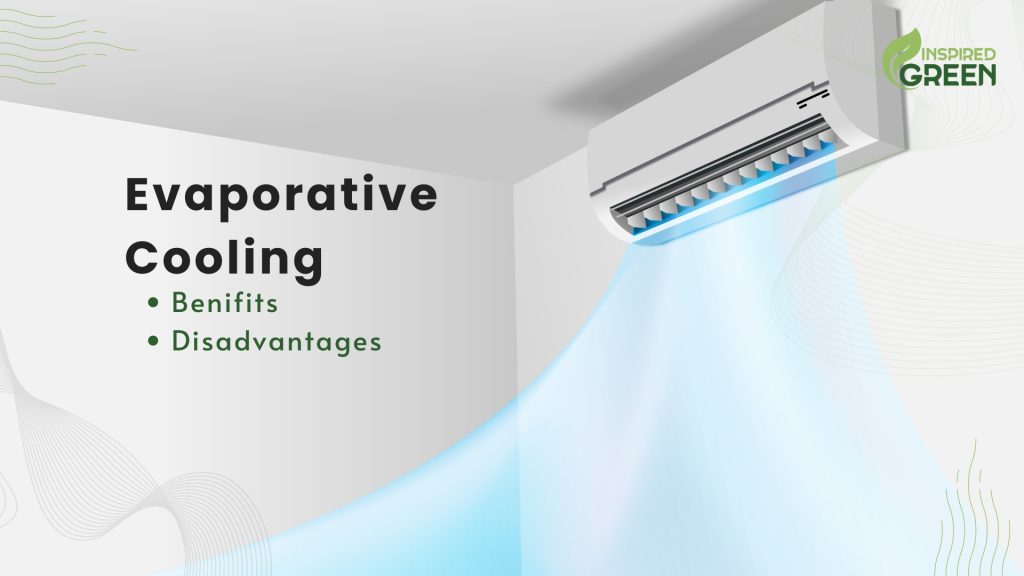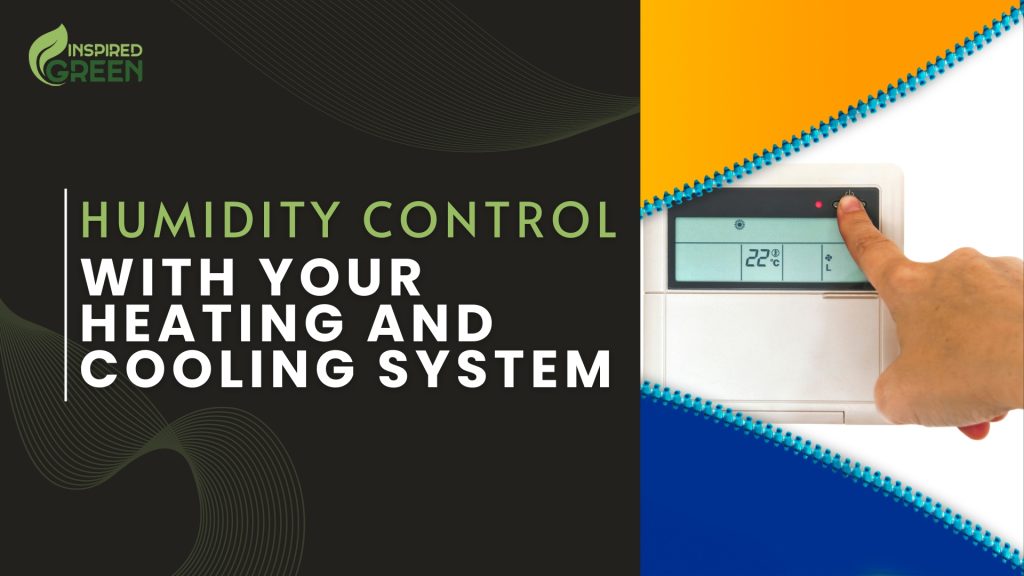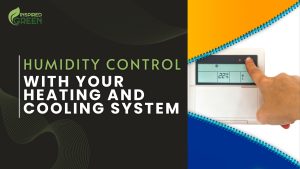Imagine being at home, but instead of feeling comfortable and cozy, your windows are foggy, your walls feel damp, and you’re constantly battling mold and mildew. This is not a scene from a horror movie but a reality for many homeowners struggling with indoor humidity.
However, this doesn’t have to be your reality forever. With correct humidity control, you can adjust and maintain a comfortable and healthy level of humidity indoors.
Humidity control is crucial to maintaining a safe and enjoyable home environment, and your heating and cooling systems play a pivotal role in this. Melbourne’s humidity has been unusually high this summer, and with a wet winter coming up, the key question is this: how exactly can you control your indoor humidity?
What is Humidity?

In essence, humidity refers to the amount of water vapor present in the air. However, this is only a snapshot of the overall story. Let’s delve deeper into this subject to help you understand its significance in your home.
There are two primary types of humidity: absolute and relative. Absolute humidity is the precise amount of moisture in the air and is expressed in grams per cubic meter. It’s a solid measure unaffected by temperature or pressure changes, but it’s often difficult to grasp because the moisture content can vary widely depending on the volume of the space under consideration.
Relative humidity is what most people use when discussing indoor humidity. This is the ratio of the current absolute humidity compared with the highest possible absolute humidity, which naturally varies with air temperature. It’s expressed as a percentage that symbolizes how full of moisture the air is. For example, a relative humidity of 50% signifies the air is half saturated with water vapor.
The outdoor climate significantly influences indoor humidity levels. In hot and humid climates, homes often grapple with excess moisture, leading to mold growth and damage to your home infrastructure, which we will discuss in detail later in the article.
However, it’s not just the outdoor climate that influences your indoor humidity. Your climate control systems, such as heating and cooling systems, also play a major role. How? These systems can either add or remove moisture from the air, ultimately affecting your comfort level and the health of you and your home.
How Do Different Climate Control Systems Impact Humidity?

The role that climate control systems play in managing indoor humidity cannot be overstated. Heating and cooling systems, in particular, are how we keep our home comfortable. Let’s take a deeper look at different forms of heating and cooling to better understand how they can impact indoor humidity.
Evaporative Cooling

Evaporative cooling is a popular method of temperature regulation in homes, particularly in dry climates. These systems work on the basic principle of evaporation, where water is converted into vapor, thereby reducing the surrounding air temperature.
Benefits
Evaporative cooling systems are renowned for their energy efficiency. By utilizing the natural evaporation process, these coolers consume significantly less electricity than traditional air conditioning systems. This makes them environment-friendly and results in lower energy bills, providing economic benefits to homeowners.
Another advantage of evaporative cooling is that it increases the humidity in the air, making your home more comfortable in dry climates. In regions with low humidity levels, the moisture added by these cooling systems can make indoor air more comfortable and less drying to the skin and sinuses. This contrasts with traditional air conditioning, which often leads to drier indoor conditions.
Disadvantages
The main disadvantage of evaporative cooling is also one of its benefits. In a humid environment, added moisture can exacerbate high indoor humidity, leading to mold growth, respiratory issues, and damage to home infrastructure.
Furthermore, evaporative coolers require regular maintenance to ensure optimal performance. This includes frequent water refills and periodic cleaning to prevent mineral deposits and mould buildup. Neglecting this upkeep can lead to inefficient cooling and potential health risks.
If you’re considering an evaporative cooling system, it’s essential to evaluate your local climate, the maintenance you’re prepared to undertake, and your specific home infrastructure needs.
Refrigerated Cooling

Refrigerated cooling systems are designed to combat the discomfort caused by hot and humid conditions. They function by removing heat and moisture from the air, providing a cool, dry atmosphere that’s highly desirable in humid climates.
At the heart of the system is the evaporator coil, where the magic truly happens. Here, the warm and moist indoor air is passed over a cold coil, removing heat from the air. Unlike evaporative coolers, refrigerative air conditioners do not add any moisture to the air during this process. This inherent design feature makes them highly effective in controlling indoor humidity levels.
Benefits
Refrigerative air conditioning offers significant benefits, particularly in its ability to control humidity levels within indoor environments. One of the primary advantages is the dehumidification process. As warm air is drawn into the unit, it passes over the evaporator coil, causing moisture in the air to condense into water droplets. This condensed water is then collected and drained, effectively reducing the humidity in the space.
This process enhances comfort by preventing the sticky, clammy feeling associated with high humidity and maintaining a healthier indoor environment. By controlling humidity, refrigerative air conditioning helps prevent mold and mildew growth, reduces the spread of dust mites, and mitigates potential health issues associated with excessive moisture, such as respiratory problems and allergies.
Disadvantages
However, refrigerative air conditioning systems also have some drawbacks.
One concern is the potential for overcooling and drying out the air. If the air conditioning system is not properly sized or calibrated, it may extract too much moisture from the air, leading to excessively low humidity levels. This can result in discomfort, dry skin, and respiratory issues for occupants.
Additionally, the energy consumption of refrigerative systems can be relatively high, contributing to increased utility bills and environmental impact. Make sure to look for units with high star energy ratings and keep your thermostat around 21 degrees for lower heating bills and to avoid excessive dryness.
Heating Systems

When the winter chill seeps into your bones, your instinctual response is to crank up the heat. However, while our heating systems provide much-needed warmth during the colder months, they can inadvertently lead to an overly dry indoor environment by reducing the humidity of the air.
A heated home with low humidity is uncomfortable and can cause a host of issues. Dry air can result in skin irritation, dry sinuses causing nosebleeds, and even increase the probability of catching the common cold or flu. The reason behind this is that the mucus membranes in our respiratory tract, which act as a protective barrier against viruses and bacteria, can dry out in low humidity, making us more susceptible to infections.
But there’s no need to sacrifice warmth for humidity. The key lies in striking the right balance.
In terms of heating systems, it’s important to understand that not all are created equal, especially regarding their impact on indoor humidity. For instance, forced-air systems tend to dry out the air more than radiant heating systems. If you’re using a forced-air system, consider installing a built-in humidifier or using portable ones to help maintain humidity levels.
It’s also worth noting that your home’s insulation plays a role in maintaining humidity levels. Well-insulated homes can retain moisture better, particularly beneficial during the heating season.
Regular maintenance of your heating system is another crucial aspect. An inefficient system can not only lead to inconsistent heating but also affect humidity levels. Have your system routinely checked and serviced to ensure it’s running optimally.
Whether you’re looking for help with ducted heating, evaporative cooling, or refrigerated heating and cooling systems, Inspired Green is here to help! We install, repair, and maintain climate control systems across Melbourne.
What is the Ideal Humidity Level For Your Home?

Achieving the right indoor humidity can be a little difficult at times. It requires precision, understanding, and sometimes, a little bit of trial and error. However, keeping your indoor humidity between 40% and 60% is essential to prevent illness and damage to your property.
Too High
Overly damp conditions, with humidity levels exceeding 60%, can become breeding grounds for mould, mildew, and dust mites. These unwelcome guests are aesthetically displeasing and can trigger allergies and exacerbate respiratory conditions such as asthma.
Too Low
On the flip side, if your humidity levels drop below 40%, you’ll find yourself in an excessively dry environment. This can lead to various discomforts, from dry and itchy skin to sore throats and irritated sinuses. Overly dry conditions can also increase your susceptibility to colds and flu and damage wooden furniture and flooring in your home.
How to Achieve the Correct Humidity Level

Now that you understand the importance of indoor humidity, let’s look at how to keep it balanced.
Monitoring
Before you make any changes, it’s important to know what your humidity levels are. One of the most straightforward methods to check this is to invest in a hygrometer, an instrument used to measure the amount of humidity in the air. These can be found relatively inexpensively online. Regularly monitoring your home’s humidity levels can help you understand if any adjustments need to be made.
Dehumidifiers and Humidifiers
A dehumidifier is one of the most effective methods to manage excess humidity. This appliance works by sucking in air from your home, removing the moisture, and then blowing it back into the room. Dehumidifiers come in various sizes, with larger ones capable of covering entire homes and smaller ones designed for specific areas such as basements or bathrooms.
On the other hand, if you’re struggling with low humidity, a humidifier is a relatively cheap way to handle the issue. It works by vaporising water and blowing it into your space with a fan, adding moisture to the air and raising humidity.
When considering a dehumidifier or humidifier, it’s essential to choose a model that aligns with the size of your space. Also, as both devices store water, they’ll need regular cleaning to prevent mould and bacteria from forming.
Ventilation
Proper ventilation is another effective way to adjust humidity. Here, it’s important to note areas prone to moisture, such as bathrooms and kitchens, and ensure they have adequate air circulation. Using exhaust fans when showering or cooking, for example, can help to prevent moisture buildup.
If you’re dealing with low humidity, try opening the windows and doors to allow fresh air in during parts of the day without extreme temperatures. This allows more moist air into the home and helps to reduce any discomfort.
Maintenance
Regular maintenance of your heating and cooling systems is paramount in managing indoor humidity levels. This includes regularly changing filters, cleaning ducts, and ensuring your systems function optimally. Poorly maintained systems can lead to increased humidity levels and potentially expensive repairs. It’s advisable to have your systems checked by a professional at least once a year, especially before high-usage seasons like summer and winter.

For expert advice and reliable heating solutions, contact Inspired Greens today !







